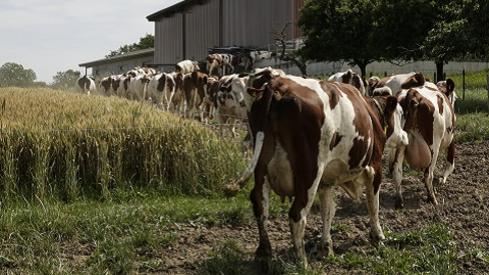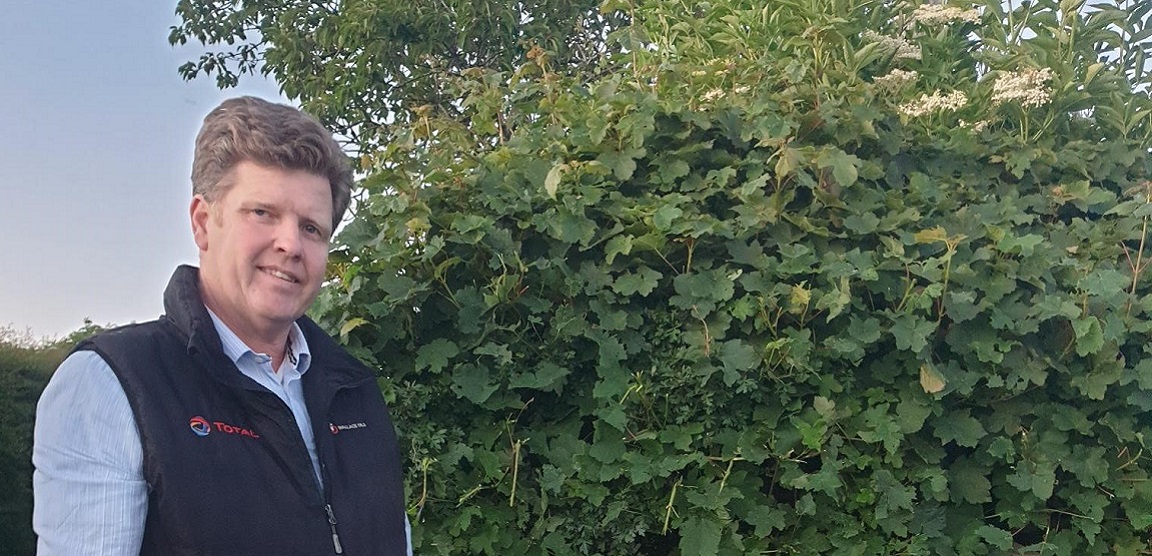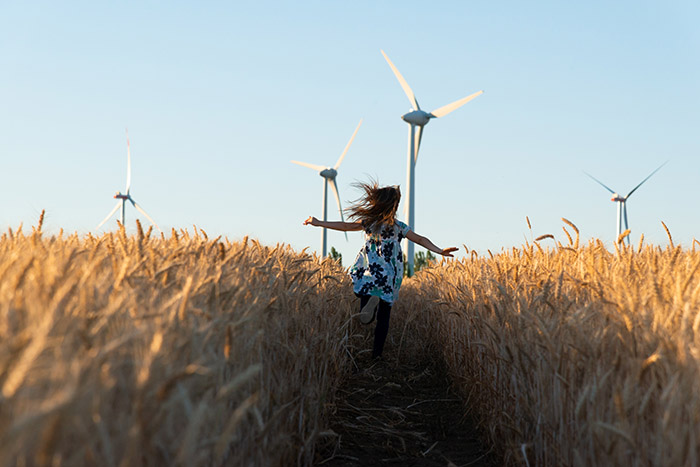Regenerative agriculture: a farmer's view

Dairy farmer Bruce Coulthard has been on the road to farming in a regenerative way for around a decade. He shares what he has learned, the ups and downs along the way, and the satisfaction gained from improving the land.
The farmer's story
Bruce Coulthard started his journey to regenerative agriculture long before the term was even known. Now he says: “I do what’s best for my land and best for the environment, where possible. I’m aligned with the regenerative farming principles.
Bruce’s father was born on the farm back in 1944, and he still regularly shows up to work on the farm. Bruce himself has been farming since he finished school in 1988, but spent his childhood helping his father. He now has one apprentice to help him. He has four school-age children.
The farm is a member of the First Milk co-operative which markets his milk.
At a glance
Choose + to see a quick summary and get the detail by selecting the link. Otherwise scroll to read everything.


It all began around 10 years ago when Bruce noticed his cows were struggling to get into calf. This was a serious worry. [...]


Just looking at his land, Bruce could see it wasn’t as healthy as it could be. It was compacted in places and there wasn’t much plant variety in the pasture. Bruce looked at his inputs, including fertiliser and trace element additives, and found he was spending £8-10k a year on minerals alone. He decided to see if there was a better way, so he started working with a soil fertility services company to get him on the right track.


The first few years transitioning from one system to another were the hardest, says Bruce. He knew he couldn’t instantly turn off the fertiliser tap, but had to wean the grass off nitrogen applications gradually. [...]


Now 8-10 years into the process Bruce no longer has to add minerals – or crushed rocks as he likes to call them - to the feed. Fertility in the herd is much improved and Bruce says you can see how much better the cows are feeling just from the shine on their coats. [...]


Bruce plans to continue on this path because he thinks regenerative farming is not only a good thing for the soil, but is beneficial in other ways.
"We can reduce energy consumption, reduce fertiliser usage and chemical usage where appropriate. Then we are actually saving a cost as well as doing a bit for the environment," he says.
It all began around 10 years ago when Bruce noticed his cows were struggling to get pregnant - to get into calf as farmers describe it. This was a serious worry.
"Unless your cows are in calf and are healthy, you're not going to do well financially," he explains.
He started looking into what might be at the root of his herd’s fertility problem, working his way through the chain, including the health of his heifers, their feed and grazing. What he discovered was that there was too much of the trace element molybdenum in the soil. This then impacts the plants growing in the soil. Once eaten and absorbed by grazing cattle an excess of molybdenum can interact with and lock out other trace minerals such as copper which the cows need for their health, growth and producing the next generation.
Bruce knew he had to make his soil healthier to rebalance the nutrients needed. He also wanted to be able to deal with the greater extremes in weather that climate change is producing.


The solution
Just looking at his land, Bruce could see it wasn't as healthy as it could be. It was compacted in places and there wasn't much plant variety in the pasture. Bruce looked at his inputs, including fertiliser and trace element additives, and found he was spending £8-10k a year on minerals alone. He decided to see if there was a better way, so he started working with a soil fertility services company to get him on the right track.
"Soil sampling was helpful in seeing what you are doing right and what you are doing wrong," he says. "Making sure the soil had the right PH, checking calcium and magnesium levels was essential. Then we were able to boost what was lacking."
Bruce began introducing herbal leys to the farm. To maintain yields and profitability, this initially required a delicate balance of slowly improving the soil health and reducing applications of nitrogen fertiliser. He also wanted to encourage the right kind of vegetation with deeper roots to help alleviate compaction and fix nitrogen in the soil, making it less hungry for fertiliser.
Avoiding a monoculture was important too – mixtures of plants can yield more than a single species, especially in poor weather.
Guidance from the Department for Environment, Food & Rural Affairs on herbal leys
For fertiliser, Bruce did a deal with a nearby chicken producer for their litter, which is now applied in the spring to help improve the first cut of silage. This helps to create a local circular economy for nutrients. And, of course, any manure the herd produces goes back into fertilising the land.
The first few years transitioning from one system to another were the hardest, says Bruce. He knew he had to wean the grass off nitrogen applications gradually.
"It can be tough to start when you compare a field with the fields that have got fertiliser on and it’s not looking as good," says Bruce. "It takes time to adapt. Most farmers are carrying as much stock as they can to pay the bills. But if you are going through the transition and trying to get rid of the fertiliser you’ll need to adjust your stocking density to match. It’s a learning curve."
While he had always thought of his farm as a whole, he began thinking about it as a whole regenerative system. Avoiding bare soil and the potential for erosion of top soil. Changing rotation patterns to reduce pests and improve soil structures. Thinking about ways of increasing biodiversity across the farm as a whole – particularly with the herbal leys.
One of the things Bruce found tricky to start with was the introduction of the herbal leys using slot seeding. This is a technique that allows new seed to be inserted into existing grass, stubble or cover crops, without the need for ploughing the soil. A specialist machine cuts a slot, inserts the seed at the right depth then closes up the slot. The main benefit of slot seeding is that it can replace ploughing and deep tillage which disturbs the soil structure and biology and releases 30-40% of the soil carbon.
Finding the right balance of discouraging the grass while encouraging the herbal ley mixture to set root and grow required experimentation. It wasn’t easy to see the benefits to start with but Bruce persevered in getting the leys properly established.
Slowly he began to see results.



The results
Now, a decade into the process Bruce no longer has to add minerals – or crushed rocks as he likes to call them - to the feed. Fertility in the herd is much improved and Bruce says you can see how much better the cows are feeling just from the shine on their coats.
The herbal leys have been "a great success" and help extend the grazing season so the cows can graze outside for more weeks per year and improve biodiversity. The land looks healthier too, Bruce says. The number of earthworms he now sees if he goes out at night with a torch to check the cows is also testament to the improvement.
But he knows it’s still an ongoing process. “We still put a tickle of fertiliser on the grazing ground,” he says, although it’s much less than half their previous application. And from time to time he uses a mineral/energy lick for the dry cows who are coming up to calving to avoid iodine deficiency.
The farm infrastructure has also been improved. The cows over-winter indoors and Bruce has invested in new, large, airy sheds to keep the cattle healthy. He’s also considering more investment in regenerative farming, including better slurry storage and updating his calf housing.
“I keep an eye on the bigger picture looking at my herd fertility with cows that come back easily into calf, cows with natural vigour, which helps reduce antibiotic usage, as well as the amount of milk they produce,” he says. “It’s a win-win. My antibiotic usage versus some other producers is far lower.”
Bruce has also planted deciduous trees in wet corners of the farm. These attract bees, as well as providing food.
"There are huge pressures on buying up land for tree planting by companies to act as carbon offset for their other activities. This is taking some farmland out of food production. But if you are planting trees why not think of food crops such as apples, cherries and pears – and making sure the right tree is in the right place," he says.
Bruce plans to continue on this path because he thinks regenerative farming is not only a good thing for the soil, but is beneficial in other ways.
"We can reduce energy consumption, reduce fertiliser usage and chemical usage where appropriate. Then we are actually saving a cost as well as doing a bit for the environment," he says.
So what does he think about his experience of opting for a regenerative system? How would he encourage other farmers to join him on the journey?
"Begin with one field and treat it with respect," Bruce advises. Regenerative farming is a mindset and the transition can be a long path. But if you start with one field you’ll eventually begin to see the benefits there and that can encourage you further."


Bruce Coulthard and Nestlé
Bruce supplies milk to dairy co-op and Nestlé supplier First Milk. The milk is turned into powder for cappuccinos.
Nestlé is an active partner with First Milk and the co-op, offering advice on the environment, including on hedgerows and fencing off of water courses. Their advisers also encourage financial benchmarking.
"We've done an antibiotic usage exercise with Nestlé which showed up different levels of usage across the group," says Bruce. "It's a useful way of knowing what other people are doing and seeing what’s achievable. It's also good to know you are on the right path with your own results."
We are also doing our best to support our goals. “We’ve just put into a contract with our feed supplier that no feed is to come from deforestation or unsustainable sources,” says Bruce.
What does Bruce think needs to be done to help promote a regenerative food system?
Some form of labelling, like the Red Tractor farm assurance mark, would be good to show customers that the farmer or producer are trying, doing as much as they can in terms of sustainability and the environment. But I do know that customers even with the best intentions in the world do often look for the cheapest thing. But it would be good to encourage those who can afford to choose to support regenerative agriculture.
Encouraging agricultural colleges so that the young farmers coming through will make the leap to the change. They can take it back to the farms with youthful enthusiasm to the farmers who will listen.
The subsidy system needs to support regenerative farming. Make money available through environmental schemes so that people will take it up. The government needs to set the right policies without loopholes. They need to back the farmers who are making a difference and making a change because we all need to be deadly serious about this and take it forward. They need to push environmental good with subsidies for the right things.
For example, grass and pasture get a poor rep compared with trees. But in a regenerative system because pasture has got more leaf than trees in their early years, that the foliage produces more photosynthesis – and it is better than bare soil. If you are using trees, then consider trees that carry crops.
We need government, agricultural colleges, ecologists and everyone in the food system to think of things in a joined-up way, think them through properly for food security, variety of crops, sustainability and carbon capture.





